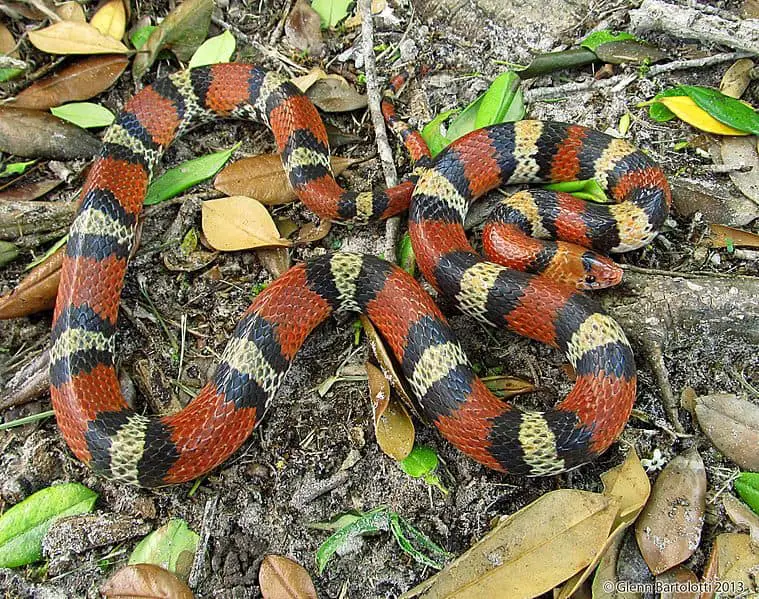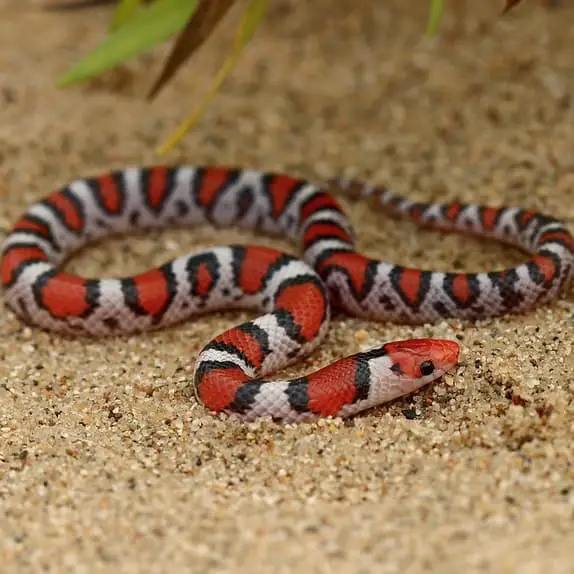The scarlet snake is a colorful nonvenomous snake that can be found in the Southeastern and the Eastern United States. Due to its coloration, it is often confused with the highly venomous eastern coral snake native to the Southeastern U.S.
Description
Scarlet snakes are white, light grey or light yellow and have several red blotches that are surrounded by a black margin on their back. Their bottom side is light grey, white or yellow. Since the colored blotches often run all the way down to the bottom side, giving the appearance of stripes, they are often confused with the venomous coral snake or the nonvenomous scarlet kingsnake.

How to tell the difference between scarlet snake and coral snake?
As mentioned, the scarlet snake shares some looks with the highly venomous coral snake. In the Southeastern United States, the ranges of these two species overlap. The easiest way to distinguish nonvenomous snakes from the coral snake is the color of the head. Both the scarlet snake as well as the scarlet kingsnake have a red head. The venomous coral snake has a black head and neck.
Also, the nonvenomous scarlet snake (and other nonvenomous, similar-looking snakes) never has two warning colors (red, orange, yellow) touching each other. There is always a black crossband between red and white/light grey/yellow. The venomous coral snake has red and yellow right next to each other.
Size
Adult scarlet snakes reach an average length of 15-26 inches (38-66 cm).
Diet and Habitat
Scarlet snakes are nocturnal snakes and spend the colder months of the year in hibernation. They live in pine forests and other wooded areas in their natural range. They feed mainly on small reptiles such as lizards and frogs as well as small rodents and eggs of birds and reptiles.
Bite
The scarlet snake is a nonvenomous snake and does not pose any threat to humans. They are generally non-agressive and are hesitant to bite humans. If they feel threatened or are picked up, they rather emit a strong foul-smelling odor hoping to rout the attacker with the smell.
However, due to its similarity with the potentially deadly coral snake, you should be able to rule out a coral snake bite 100%. A coral snake bite may only have minor effets at first and severe symptoms often only appear after 24 hours after the bite. Once the symptoms have set in, seeking medical attention may already be too late. Therefore you should always consult a medical professional if you are unsure what red, black and yellow snake has bitten you.
Scarlet snake range in the USA
The scarlet snake can be found in the Southeast and East of the United States in the following states: Texas, Oklahoma, Arkansas, Louisiana, Mississippi, Alabama, Georgia, Florida, South Carolina, North Carolina, Tennessee, Kentucky, Illinois, Indiana, Missouri, Virginia, Delaware, Maryland and New Jersey.
Scientific classification of Cemophora coccinea
- Kingdom: Animalia
- Phylum: Chordata
- Class: Reptilia
- Order: Squamata
- Suborder: Serpentes
- Family: Colubridae
- Genus: Cemophora
- Species: Cemophora coccinea
Currently, two subspecies are recognized:
- Cemophora coccinea coccinea – Florida scarlet snake
- Cemophora coccinea copei – northern scarlet snake
